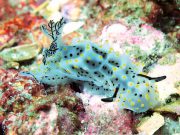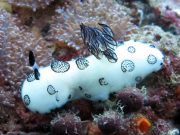Discodorididae nudibranchs are found at many dive sites, especially when diving around Lanta.
Many members of the Discodorididae family have flattened backs with numerous coloured tubercles (bumps), similar to Wart Slugs, and a wide mantle skirt. The larger and brighter tubercles (bumps) are often located along the edge of several ridges which run along the back of the nudibranch.
As with other nudibranch families, many members of this family can secrete toxic acids through the skin of the dorsal mantle as a defensive measure.
Discodorididae Nudibranchs may withdraw their gills and rhinophores (tentacles on top of the head) into pockets when disturbed in order to protect themselves.
4 species found on this page.
Strickland's Halgerda
(Halgerda stricklandi)
Halgerda stricklandi @ Koh Haa
Strickland's Halgerda has a pale to whitish body colour with numerous tubercles (warty bumps) of varying sizes, coloured yellow to orange to pink to red.
Some of the larger tubercles are atop ridges, however the majority are not. The larger tubercles are surrounded by a faint white ring.
Strickland's Halgerda @ Koh Haa
The rhinophore (head tentacles) stems and the gill branches are whitish with dark markings, spots and edges, particularly to the rear edges
Strickland's Halgerda grows up to 5 cm.
Halgerda punctata
(Halgerda punctata)
Halgerda punctata @ Koh Haa
Halgerda punctata has a translucent white body with numerous dark spots and many yellow-tipped tubercles on the ridges. The sides of the ridges and body have dark spots, which also extend to the foot.
The front of the head has mostly yellow spots, not on ridges.
The rhinophore (head tentacles) are dark coloured, with a dark streak along the body to the rear. The thicker gill stems may be translucent white, with the thinner upper gill stems being dark coloured.
Halgerda punctata grow to 5 cm.
Tessellated Halgerda
(Halgerda tesselata)
Halgerda tesselata @ Koh Rok
The Tessellated Halgerda is easily identified due to the tessellated pattern of geometric reddish-brown to orange ridges and shapes on the body.
The ridges are filled with many tiny white spots on a black background.
The Tessellated Halgerda has white gills with dark margins. The rhinophores have a white under colour with dark spots and margins.
The Tessellated Halgerda grows to 3.5 cm.
Funeral Jorunna
(Jorunna funebris)
Jorunna funebris @ Koh Phi Phi
The Funeral Jorunna, also known as the Dotted Nudibranch, has a distinctive two-tone colouration that is easy to identify.
The body is uniformly white, with black or brown spot-filled rings. The rhinophores and gills are the same colour as the body spot-filled rings.
The Funeral Jorunna grows to 5 cm and is found among sand and rubble areas of coral and rocky reefs.
The diet includes eggs and blue sponges of the genus Haliclona.





